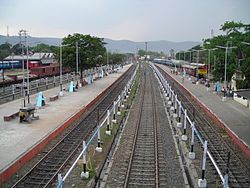Sahibganj
| Sahibganj (Hindi: साहिबगंज जिला) | |
|---|---|
| city | |

Sahibganj railway station
|
|
| Location in Jharkhand, India | |
| Coordinates: 25°15′N 87°39′E / 25.25°N 87.65°ECoordinates: 25°15′N 87°39′E / 25.25°N 87.65°E | |
| Country |
|
| State | Jharkhand |
| District | Sahibganj |
| Area | |
| • Total | 1,601 km2 (618 sq mi) |
| Elevation | 16 m (52 ft) |
| Population (2001) | |
| • Total | 80,154 |
| • Density | 719/km2 (1,860/sq mi) |
| Languages | |
| • Official | Hindi, Santali |
| Time zone | IST (UTC+5:30) |
| PIN | 816109 |
| Telephone code | 06436 |
| Vehicle registration | JH-18 |
| Sex ratio | 948 ♂/♀ |
| Website | sahibganj |
Sahebganj (Hindi: साहिबगंज) (also known as Sahibganj) is a town and Municipality of Sahebganj district (Hindi: साहिबगंज जिला) of Jharkhand state, India, which also serves as the district headquarters for Sahibganj District.
Sahibganj means a place (ganj) of masters (sahebs or sahibs).
Sahibganj is a Class II town of Jharkhand which is sandwiched between River Ganga on the north, Rajmahal Hills on the south, State of Bengal on the East and one of the world's oldest university, Vikaramshila (in Bhagalpur District) of Bihar on the west.
The place is likely to have been given its name because a number of English and other European people lived and worked in and around the railway station during the British Raj. The town is cosmopolitan, with people from Bihar, Bengal, and Jharkhand; and refugees from Bangladesh and Pakistan.
The history of Sahibganj town centers mainly on the history of Rajmahal and Teliagarhi Fort. There is evidence that the area is inhabited since time immemorial only by Malers (Mal Paharia). They were the early settlers of the territory of Rajmahal hills, who still reside in some areas of the same hills. They are considered to be the “Malli” mentioned in the notes of Megasthenese, Greek Ambassador of Selukus Nikater, who happened to be in the vicinity of Rajmahal hills in 302 BC. Till the visit of Chinese traveller Hiuen Tsang in 645 AD, the history of this area was wrapped in obscurity. In his travelogue the Chinese pilgrim mentions about the Fort of Teliagarhi (on the rail route, near Mirzachauki Railway Station), when he saw the lofty bricks and stone tower not far from the Ganges. Information is gathered through the pages of history that it was a Buddhist Vihar.
A continuous history of the district is available from the 13th century when Teliagarhi became the main gateway of Muslim armies marching to and from Bengal. During the Turkish dynasty rule in Delhi, Malik Ikhtiaruddin-bin-Bakhtiar Khilji marched towards Bengal and Assam through Teliagrahi pass. He captured Bengal and its king Lakshaman Sena fled away to Cooch Behar (in West Bengal).
...
Wikipedia


